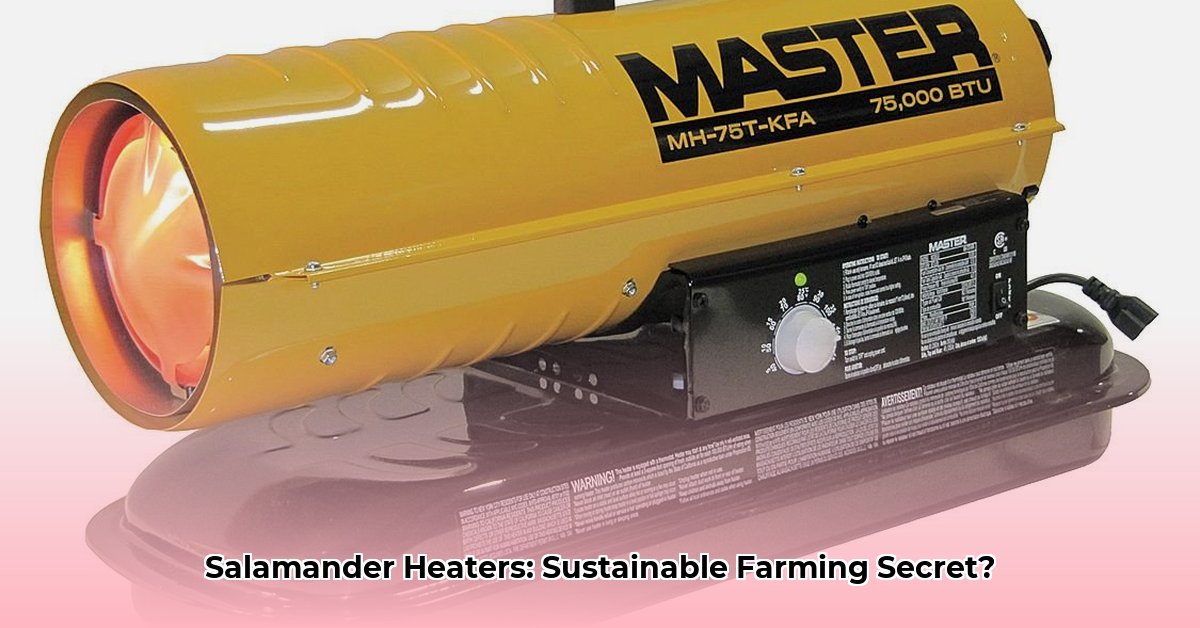
Keeping your crops and livestock healthy and productive while minimizing environmental impact is a constant challenge for sustainable farmers. Unexpected frosts, the need for supplemental heat in greenhouses, and maintaining optimal brooding temperatures for poultry all demand reliable and efficient heating solutions. This guide explores how salamander heaters, readily available at Tractor Supply, can be effectively integrated into your sustainable agricultural practices. We'll explore their application in frost protection, seed starting and greenhouse heating, and poultry brooding, while emphasizing safety and efficiency. For more information on Buddy Heaters, check out this helpful resource.
Protecting Crops from Frost: A Localized Approach
Sudden frost can devastate crops. Salamander heaters offer a surprisingly effective way to protect vulnerable plants without heating an entire field. By creating localized warm air pockets, you minimize energy waste and maximize your impact.
Step-by-Step Guide:
- Strategic Placement: Position the heater downwind of the plants to create a warm air shield. Think of it as building a small, protective microclimate.
- Prioritize Ventilation: Adequate ventilation is critical to prevent the dangerous buildup of carbon monoxide. Never use a salamander heater in an enclosed space without proper airflow.
- Monitor Temperatures: Regularly check temperatures near the plants using an outdoor thermometer. Adjust the heater’s output as needed to maintain optimal warmth. Consistent monitoring is key.
- Fuel Efficiency: Use only the necessary amount of propane. Overheating wastes fuel and is environmentally unfriendly. Plan your fuel needs and consider factors such as frost duration and protected area size. Could you consider switching to a more sustainable fuel source in the future?
Seed Starting and Greenhouse Heating: A Supplemental Solution
Salamander heaters can serve as a cost-effective supplemental heat source for small-scale greenhouses or indoor seed starting. While not as energy-efficient as larger systems, their portability is a significant advantage.
Best Practices:
- Ventilation: Ensure adequate airflow to maintain healthy plant growth and prevent the accumulation of harmful gases. Remember, good ventilation is crucial.
- Temperature Control: Maintain appropriate temperatures for the specific plants. Research your crops' needs to ensure optimal growth.
- Monitoring: Closely monitor temperatures, especially during nighttime, to address any fluctuations. Consistent monitoring ensures success.
Poultry Brooding: Maintaining Optimal Chick Temperatures
Maintaining the right temperature in a poultry brooder is essential for chick survival and growth. Salamander heaters can provide supplemental heat, but safety must be prioritized.
Safe and Effective Brooding:
- Safe Distance: Position the heater outside the brooder, ensuring chicks cannot directly contact it to prevent burns.
- Temperature Control: Use a thermometer to monitor temperatures and adjust the heater to maintain the optimal range for your chicks’ age (remember, this range changes as chicks grow).
- Ventilation: Ensure sufficient ventilation to prevent the buildup of carbon monoxide and maintain a healthy environment for your chicks. Fresh air is essential for healthy development.
Weighing the Pros and Cons: A Balanced Perspective
Salamander heaters offer several benefits, but also have limitations. It's crucial to understand both to make informed decisions.
| Feature | Advantages | Disadvantages |
|---|---|---|
| Portability | Easily moved and repositioned. | Limited heating range, not ideal for large areas. |
| Initial Cost | Relatively inexpensive compared to other systems. | Ongoing propane costs can increase with extended use. |
| Targeted Heating | Allows localized heating, saving energy compared to whole-field heating. | May not suffice for areas needing extensive heating applications. |
| Ease of Use | Simple operation and maintenance. | Requires regular propane refills. |
| Safety | Risk of carbon monoxide poisoning if ventilation is inadequate. | Requires careful monitoring to prevent accidents. |
Conclusion:
Salamander heaters provide a practical, cost-effective heating solution for small-scale sustainable agriculture. However, responsible use, including diligent monitoring and attention to safety standards, is paramount. By strategically deploying these heaters and prioritizing safety, farmers can improve the efficiency and resilience of their operations while minimizing their environmental impact. Remember, continual learning and adapting to the best practices in sustainable agriculture are essential!